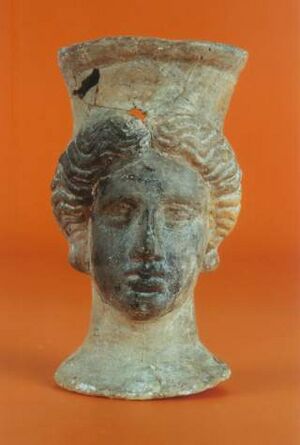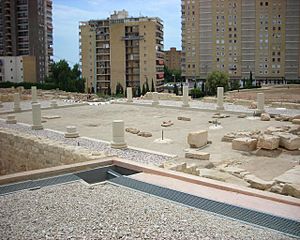Lucentum facts for kids

The archaeological site is surrounded by the buildings of modern Alicante.
|
|
| Location | Alicante, Province of Alicante, Valencian Community, Spain |
|---|---|
| Coordinates | 38°21′52″N 00°26′18″W / 38.36444°N 0.43833°W |
| Type | Settlement |
| History | |
| Founded | End of the 3rd century BC |
| Abandoned | Between the 2nd and 3rd centuries AD |
Lucentum was an ancient city that existed before modern Alicante in Spain. It was a Roman city, but it also had Carthaginian roots. Today, you can visit the ruins of Lucentum at a place called El Tossal de Manises. It's like a time capsule showing us how people lived long ago!
Contents
Lucentum's Early History
Some historians believe that Lucentum was founded by Hamilcar Barcas. He was a famous leader from Carthage, an ancient empire. The city was an important trading hub near the Mediterranean Sea.
People in Lucentum traded with ancient Greece, Phoenicia, and the city of Tartessos. This mix of cultures created a unique local culture. The ancient Greeks called this place the "White Promontory" or "White Citadel." This name likely came from its Punic (Carthaginian) name.
Becoming a Roman City
Lucentum grew the most between 100 BC and 100 AD. Most of the ruins you see today are from the Roman period. The Roman general Publius Cornelius Scipio conquered the area during the Second Punic War. After this, the city was renamed Lucentum. This name comes from a Latin word meaning "to shine," also referring to the "white promontory."
The city became very Roman over time. It had public baths, a central meeting place called a forum, temples, and even sewers. It was one of the main cities in the Roman province of Hispania Tarraconensis.
Why Lucentum Declined
Lucentum started to decline in the 2nd century AD. By the end of the 3rd century, it was mostly abandoned. The main reason was competition from a nearby city called Ilici (modern Elche). Ilici had better access to water and easier land routes for trade.
Eventually, Lucentum became completely empty. For a while, the site was only used as a Muslim cemetery in the 10th and 11th centuries.
Discovering Ancient Lucentum
In 1780, a man named Count of Lumiares suggested that the ruins at Tossal de Manises were actually Lucentum. He had been digging there for years. Before this, most people thought the Roman city was far from Alicante.
Later, other archaeologists found even older Carthaginian parts of the city. In the 1930s, a burial ground was discovered during road construction. Many items from this burial ground are now in the Archaeological Museum of Alicante.
What We Found at the Site
The site shows evidence of both Iberian and Roman times. The Roman city was built on top of the older Iberian one. Not much of the Iberian city remains, except for parts of its walls.
Items found include:
- Special pots and vases.
- Iberian pottery with designs of geometric shapes, birds, and fish.
- Sculptures and jewelry.
- Amulets from Ancient Egypt.
- Terracotta items (baked clay).
- Weapons.
Some jewelry found suggests there was a local workshop. They made pendants that were found in other burial sites nearby. A famous statue called the "Kore de Alicante" might also have come from this site. It is now in the Archaeological Museum of Catalonia.
Protecting the Ruins
After World War II, the Lucentum site was in danger. It has great views of the old lagoon and bay, so people wanted to build tall buildings there. But people who wanted to save the site fought to protect it. A Swedish archaeologist named Solveig Nordström was very important in this effort.
In 1961, Lucentum was named an "Artistic and Historic Monument." This gave it some legal protection. However, many buildings were still built around the site. This means the ruins are now surrounded by modern structures.
For many years, the ruins were neglected. But in the 1990s, efforts began to preserve them. New construction was done to protect what remains of the ruins. This project was a big step for the culture of Alicante.
Lucentum Today
Today, you can visit the archaeological site of Lucentum. It covers an area of about 30,000 square meters.
Some of the most interesting things to see are:
- The remains of the strong defensive walls.
- Foundations of pre-Roman defense towers.
- Parts of the ancient baths.
- The Roman forum.
- A section of the Muslim cemetery.
- Many old houses.
More parts of El Tossal de Manises are still being excavated. This means the site might become even bigger and more important!
The name Lucentum is still important in the area. Many businesses, groups, and sports clubs in Alicante use the name of this ancient city.
See also
 In Spanish: Lucentum para niños
In Spanish: Lucentum para niños
- Roman Hispania
- History of Alicante
- Timeline of Alicante





